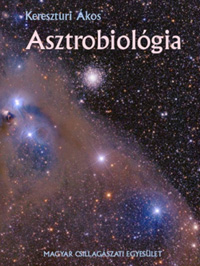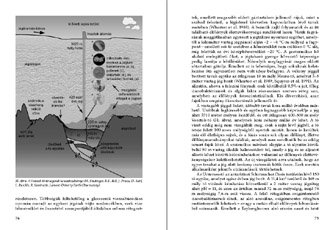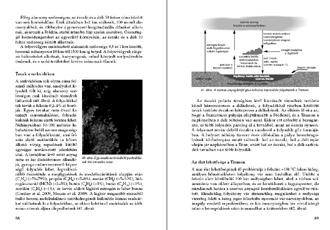 Astrobiology
Astrobiology
by Akos Kereszturi
publisher: Hungarian Astronomical Association, Budapest, 2011
The book in Hungarian language reviews our up-to date information on the possibility of life beyond the Earth, a new interdisciplinary field called astrobiology. The book outlines the formation of various chemical elements, the interstellar chemical processes, and the formation of planets plus the known characteristics of exoplanets. It provdes information on the astrobiological potential of different planetary bodies like Enceladus, Titan (satellites of Saturn), Europa (satellite of Jupiter) and Mars.
Some chapters are dedicated to present our current knowledge on the origin of life on Earth and living organisms in extreme conditions on our planet, like in deserts, deep see hydrothermal systems, inside permafrost or pure ice. With 180 pages, 75 figures, 14 tables and a detailed index this book could serve as a manual for anybody interested in the recent results on the research for life beyond the Earth. The figures are available free with english text on request by sending an email to the author. Small thumbnail version of the images can be seen below.
Figures and of the publication and infographics on astrobiology (available with english text on email request):
Contents
|
- Introduction
- Formation of atomic nuclei
- Nucleosynthesis at the third minute
- Nucleosynthesis inside the stars
- Nucleosynthesis in interstellar space
- Molecule formation in interstellar space
- Organic components
- Planet formation and exoplanets
- Protoplanetary disks
- Brown dwarfs
- The "real" exoplanets
- General properties of exoplanets
- Exoplanet types
- Atmospheric components, biomarkers
- The origin of life on Earth
- The concept of extra terrestrial life
- Characteristics of the early Earth
- Prebiotic evolution
- The RNA world
- Major steps in the evolution of life
- Extreme environments and extremophiles on Earth
- Important enxtremophile groups
- Black smokers
- White smokers
- Permafrost
- Life inside ice
|
- Cryptobiotic crust
- Atacama desert
- High lakes
- Rio Tinto
- Dry Valleys on Antarctica
- Astrobiology of the Solar system
- Astrobiological potential of Enceladus
- Potential analogues on Earth
- Astrobiological potential of Titan
- Water ice surface, methane rivers
- Possibility of life on Titan
- Astrobiological potential of Europa
- Intriguing surface features
- Active processes today
- Geological history
- Astrobiological potential of Mars
- Early surface conditions
- Where shall we look for signs of life
- Meteorites from Mars
- Surface conditions today
- Methane, the potentially biogenic gas
- Results from the Viking probes
- Pyrolitic release
- Gas exchange
- Labeled release
- Search for organic materials
- Observations by the Phoenix probe
|
- Idea of peroxide based life
- The DDS-MNSO model
- Experiments in Mars simulation chambers
- Panspora, pansmermia theories
- Start from a planet
- Travel in interplanetary space
- Landing on a habitable planet
- Field tests
- Habitability and habitable zones
- Habitability: characteristics of the planets
- Habitability: characteristics of the stars
- Habitability: characteristics of the galactic environment
- Astrobiology in education
- Topics and ideas to implement astrobiololgy in university courses
- Websites for astrobiology
- Glossary
- References
|

|

|
Subject index:
2M1207, 51 Peg b, 55 Cnc, AA Tauri, acidophil, adenin, Aguas Calietes, ALH84001, alkalophile, aromatic hydrocarbons, Atacama desert, atmosphere, autocatalytic processes, Bacterium subtilis, Barberton greenstone belt, blood falls, carbonaceous chondrite, cave, brown dwarf, barophile, Becquerel crater, beta Pictoris, biomarker, BIOPAN, biosignature, black smokers, carbamide, carbonate paradox, Cassini probe, chemoton, chemosynthesis, Chicxulub crater, chirality, chondrite, Chroococcidiopsis, CHZ, cianobacteria, circumstellar habitable zones, clathrate, clay minerals, climate, Collegium Budapest, continents, core accretion model, coronograph, CoRoT-7b, CoRoT space telescope, crater, cryoconite, cryptobiotic crust, cryopeg, stars, DDS-MSO hypothesis, Death Valley, Deep Impact probe, Deinococcus radiodurans, delta, deuterium, diamond, DIB, diffuse interstellar bands, disk instability, Dione, DNA, dormant phase, dune spot, dust devil, E-ring, Earth, EET 92042, Ediacara fauna, Enceladus, endolithic, enzyme, eucariota, Europa, eutectic, evaporite, exoplanet, EXPOSE-R, extremophile, faint young proto-sun paradox, first generation exoplanets, FOTON satellite, fullerene, fusion, galactic habitable zone, gamma Cep, geothermic, GHZ, giant planet, Gl 86, glicine, global snowball, Gliese 581, Gliese 876, GRA 095577, graphite, habitability, greenhouse effect, habitable zone, halophile, HATnet, HAT-P-1b, hot Jupiters, hot Earths, HD 114762 30, HD 188753 Ab, HD 189733 b, HD 209458 b, HD 41004 a, helium, Hertzsprung-Russell diagram, Hematite-region, hydrothermal, hipertermophile, hipolitic, High Lake Project, hypernova, hiperoxide, HLP, HR 8799 c, Hubble Space Telescope, Hyperion, interfacial water, interplanetary dust, impact, interstellar material, Io, iota Dra b, Isua, Ivuna meteorite, Jack Hills conglomerate, Jezero crater, JSC Mars-1, JWST, cambrian explosion, chaotic terrain, karbamide, Kepler space telescope, labeled release, Lake Hoare, Lake Vostok, Last Universal Common Ancestor, late heavy bombardment, LDEF satellite, Lendület project, LHB, Lake Licancabur, life criteria, lito-autotroph, litopanspermia, Lost City, LR, LUCA, magnetic field, Mars, Mars meteorite, MarsTox, mars simulation chamber, MARTE, main sequence, McMurdo valleys, metabolic system, methane, methane monsoon, methanogen, metaltolerant, meteorites, migration planetary, micrometeorite, Millbillie meteorite, molecular cloud, montmorillonite, Murchison meteorite, mu Arae, neutron capture, nitrifying, nucleosynthesis, methanogen, magnetosome, molecules, Nakhla meteoritet, nucleotide, occultation, oligotroph, Oph 16225-240515, Opportunity rover, orbital resonance, organic material, Orgueil meteorite, Orion nebula, oxidant, oxygen, prebiotic, primordial atmosphere, radioactive, radioresistant, Rare Earth hypothesis, PAH, panspora, panspermia, perchlorate, permafrost, peroxide, phyllosilicates, Phoenix probe, photosynthesis, Pilbara, PLATO, poliextremophil, planetary nebula, polimerization, prokaryote, proplid, protoplanet, protostar, protoplanetary disk, policyclic aromatic hydrocarbon, PSR B1257+12 b, PSR B1620-26 c, psychrophile, pulsar, r-process, radioactive decay, red dwarfs, red edge, ribozyme, RNA, RNA word, runoff channels, S Ori, s-process, Sagittarius B2, scattered exoplanets, Schirmacher Oasis, second generation exoplanets, SIM-Lite, snow line, Solar System, salt, SPICA, Spirit rover, Spitzer space telescope, sporulation, STONE experiment, radioresistance, Surveyor-3, SWEEPS-10 b, Synechococcus, stromatolite, super-Earth, supernova explosion, T Tauri, Tatoone, Taylor glacier, technomarker, thermoacidophile, termophile, tides, Tiger stripes, Titan, ultraviolet radiation, ultrashort period exoplanet, Lake Untersee, Urey-Miller experiment, upsilon And, V391 Peg b, Venus, Viking probe, water activity, VRE, Wild-2, Warrawoona greenstone belt, Webb space telescope, white smokers, Yamato, Zagami meteorite, zircon
Hungarian version
|
 Astrobiology
Astrobiology
